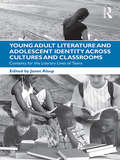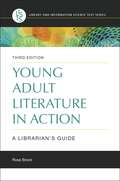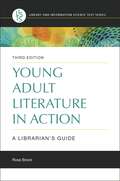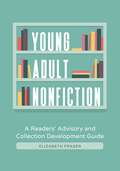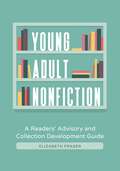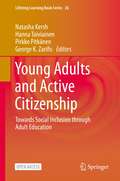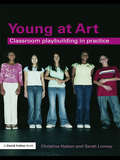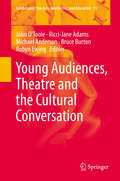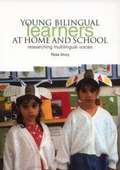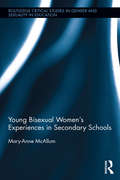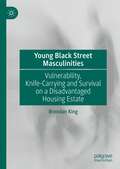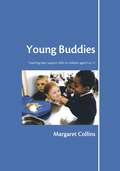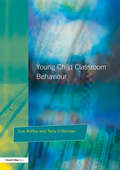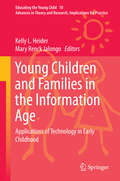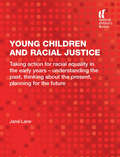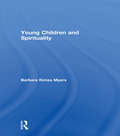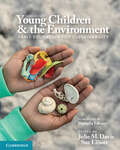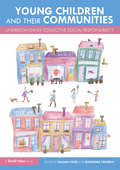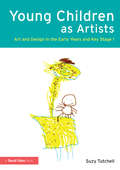- Table View
- List View
Young Adult Literature and Adolescent Identity Across Cultures and Classrooms: Contexts for the Literary Lives of Teens
by Janet AlsupTaking a critical, research-oriented perspective, this exploration of the theoretical, empirical, and pedagogical connections between the reading and teaching of young adult literature and adolescent identity development centers around three key questions: Who are the teens reading young adult literature? Why should teachers teach young adult literature? Why are teens reading young adult literature? All chapters work simultaneously on two levels: each provides both a critical resource about contemporary young adult literature that could be used in YA literature classes or workshops and specific practical suggestions about what texts to use and how to teach them effectively in middle and high school classes. Theorizing, problematizing, and reflecting in new ways on the teaching and reading of young adult literature in middle and secondary school classrooms, this valuable resource for teachers and teacher educators will help them to develop classrooms where students use literature as a means of making sense of themselves, each other, and the world around them.
Young Adult Literature and Adolescent Identity Across Cultures and Classrooms: Contexts for the Literary Lives of Teens
by Janet AlsupTaking a critical, research-oriented perspective, this exploration of the theoretical, empirical, and pedagogical connections between the reading and teaching of young adult literature and adolescent identity development centers around three key questions: Who are the teens reading young adult literature? Why should teachers teach young adult literature? Why are teens reading young adult literature? All chapters work simultaneously on two levels: each provides both a critical resource about contemporary young adult literature that could be used in YA literature classes or workshops and specific practical suggestions about what texts to use and how to teach them effectively in middle and high school classes. Theorizing, problematizing, and reflecting in new ways on the teaching and reading of young adult literature in middle and secondary school classrooms, this valuable resource for teachers and teacher educators will help them to develop classrooms where students use literature as a means of making sense of themselves, each other, and the world around them.
Young Adult Literature in Action: A Librarian's Guide (Library and Information Science Text Series)
by Rose BrockTaking a genre approach, this overview of young adult literature shows new librarians and library science students the criteria to use for selecting quality books, including recommended titles.This third edition of Young Adult Literature in Action draws on the success of the previous two editions authored by Rosemary Chance, updating and expanding on them to meet the needs of today's librarians and library science students. It includes a new focus on diverse books, LGBTQ+ selections, the role of book formats, and the relevance of librarians serving teen populations and is an ideal resource for teaching young adult literature courses.Organized by major genre divisions, this easy-to-use book includes new information on timely topics such as audio and e-books, accessible books, and graphic novels. Each chapter includes revised and updated information on collaborative activities, featured books, special topics and programs, selected awards and celebrations, historical connections, recommended resources, issues for discussion, author comments, and assignment suggestions. Further updates include citations of exemplary young adult books and award winners, references, websites, and a bibliography.
Young Adult Literature in Action: A Librarian's Guide (Library and Information Science Text Series)
by Rose BrockTaking a genre approach, this overview of young adult literature shows new librarians and library science students the criteria to use for selecting quality books, including recommended titles.This third edition of Young Adult Literature in Action draws on the success of the previous two editions authored by Rosemary Chance, updating and expanding on them to meet the needs of today's librarians and library science students. It includes a new focus on diverse books, LGBTQ+ selections, the role of book formats, and the relevance of librarians serving teen populations and is an ideal resource for teaching young adult literature courses.Organized by major genre divisions, this easy-to-use book includes new information on timely topics such as audio and e-books, accessible books, and graphic novels. Each chapter includes revised and updated information on collaborative activities, featured books, special topics and programs, selected awards and celebrations, historical connections, recommended resources, issues for discussion, author comments, and assignment suggestions. Further updates include citations of exemplary young adult books and award winners, references, websites, and a bibliography.
Young Adult Nonfiction: A Readers' Advisory and Collection Development Guide
by Elizabeth FraserCovering more than 500 titles, both classics and newer publications, this book describes what titles are about and why teens would want to read them.Nonfiction has been the workhorse of many young adult library collections—filling information and curricular needs—and it is also the preferred genre for many teen readers. But not all nonfiction is created equal. This guide identifies some of the best, most engaging, and authoritative nonfiction reads for teens and organizes them according to popular reading interests. With genres ranging from adventure and sports to memoirs, how-to guides and social justice, there is something for every reader here.Similar fiction titles are noted to help you make connections for readers, and "best bets" for each chapter are noted. Notations in annotations indicate award-winning titles, graphic nonfiction, and reading level. Keywords that appear in the annotations and in detailed indexes enhance access. Librarians who work with and purchase materials for teens, including YA librarians at public libraries, acquisitions and book/materials selectors at public libraries, and middle and high school librarians will find this book invaluable.
Young Adult Nonfiction: A Readers' Advisory and Collection Development Guide
by Elizabeth FraserCovering more than 500 titles, both classics and newer publications, this book describes what titles are about and why teens would want to read them.Nonfiction has been the workhorse of many young adult library collections—filling information and curricular needs—and it is also the preferred genre for many teen readers. But not all nonfiction is created equal. This guide identifies some of the best, most engaging, and authoritative nonfiction reads for teens and organizes them according to popular reading interests. With genres ranging from adventure and sports to memoirs, how-to guides and social justice, there is something for every reader here.Similar fiction titles are noted to help you make connections for readers, and "best bets" for each chapter are noted. Notations in annotations indicate award-winning titles, graphic nonfiction, and reading level. Keywords that appear in the annotations and in detailed indexes enhance access. Librarians who work with and purchase materials for teens, including YA librarians at public libraries, acquisitions and book/materials selectors at public libraries, and middle and high school librarians will find this book invaluable.
Young Adults and Active Citizenship: Towards Social Inclusion through Adult Education (Lifelong Learning Book Series #26)
by Pirkko Pitkänen George K. Zarifis Hanna Toiviainen Natasha KershThis open access book sheds light on a range of complex interdependencies between adult education, young adults in vulnerable situations and active citizenship. Adult education has been increasingly recognized as a means to engage and re-engage young adults and facilitate their life chances and social inclusion thus contributing to an active citizenship within their societal contexts. This collection of chapters dealing with issues of social inclusion of young people represents the first book to explicitly approach the complex interdependencies between adult education, young adults in vulnerable situations and active citizenship from the European perspective. Social exclusion, disengagement and disaffection of young adults have been among the most significant concerns faced by EU member states over the last decade. It has been increasingly recognised by a range of stakeholders that there is a growing number of young people suffering from the various effects of the unstable social, economic and political situations affecting Europe and its neighbouring countries. Young adults who experience different degrees of vulnerability are especially at risk of being excluded and marginalised. Engaging young adults through adult education has been strongly related to addressing the specific needs and requirements that would facilitate their participation in social, economic and civic/political life in their country contexts. Fostering the active citizenship of young people, both directly and indirectly, is an area where many AE programmes overlap, and this has become a core approach to integration.This book considers social, economic and political dimensions of active citizenship, encompassing the development of social competences and social capital, civic and political participation and the skills related to the economy and labour market. The cross-national consideration of the notions of vulnerability, inclusion and active citizenship underpins the complexity of translating these concepts into the national contexts of adult education programmes.
Young At Art: Classroom Playbuilding In Practice (PDF)
by Christine Hatton Sarah LovesyYoung at Artis a practical guide to playbuilding for teachers working with students at an upper primary and secondary level. Focusing on an area often neglected in traditional drama text books, the book covers the process of devising drama, and the teacher's role in facilitating students to collectively become playwrights, actors, designers, directors and critics of their ensemble work. The playbuilding process is covered in a structured manner, which includes: Mapping the Territory: identifying critical issues relating to teaching and learning in playbuilding, and laying the basic foundations of understandings and practice. Levels at Work: offering three approaches to playbuilding, catering for a range of learning experiences. Playbuilding for All: explores theatre practitioners' techniques, working with students' personal stories and narratives and playbuilding with a contemporary edge. An essential guide for all drama teachers Young at Artcovers practical teaching issues and strategies for working with groups of students to help them perform their playbuilt stories to an audience, as well as techniques for student assessment and evaluation, providing a wealth of exemplary starting points and approaches. The book offers detailed guidance on working with students to help facilitate the collaborative creative and reflective processes, offering practical ideas and structures which can be easily implemented in the classroom.
Young at Art: Classroom Playbuilding in Practice
by Christine Hatton Sarah LovesyYoung at Art is a practical guide to playbuilding for teachers working with students at an upper primary and secondary level. Focusing on an area often neglected in traditional drama text books, the book covers the process of devising drama, and the teacher’s role in facilitating students to collectively become playwrights, actors, designers, directors and critics of their ensemble work. The playbuilding process is covered in a structured manner, which includes: Mapping the Territory: identifying critical issues relating to teaching and learning in playbuilding, and laying the basic foundations of understandings and practice. Levels at Work: offering three approaches to playbuilding, catering for a range of learning experiences. Playbuilding for All: explores theatre practitioners’ techniques, working with students’ personal stories and narratives and playbuilding with a contemporary edge. An essential guide for all drama teachers Young at Art covers practical teaching issues and strategies for working with groups of students to help them perform their playbuilt stories to an audience, as well as techniques for student assessment and evaluation, providing a wealth of exemplary starting points and approaches. The book offers detailed guidance on working with students to help facilitate the collaborative creative and reflective processes, offering practical ideas and structures which can be easily implemented in the classroom.
Young Audiences, Theatre and the Cultural Conversation (Landscapes: the Arts, Aesthetics, and Education #12)
by John O’Toole Ricci-Jane Adams Michael Anderson Bruce Burton Robyn EwingThis volume offers rare insights into the connection between young audiences and the performing arts. Based on studies of adolescent and post-adolescent audiences, ages 14 to 25, the book examines to what extent they are part of our society’s cultural conversation. It studies how these young people read and understand theatrical performance. It looks at what the educational components in their theatre literacy are, and what they make of the whole social event of theatre. It studies their views on the relationship between what they themselves decide and what others decide for them. The book uses qualitative and quantitative data collected in a six-year study carried out in the three largest Australian States, thirteen major performing arts companies, including the Sydney Opera House, three state theatre companies and three funding organisations. The book’s perspectives are derived from world-wide literature and company practices and its significance and ramifications are international. The book is written to be engaging and accessible to theatre professionals and lay readers interested in theatre, as well as scholars and researchers. “This extraordinary book thoroughly explains why young people (ages 14-25+) do and do not attend theatre into adulthood by delineating how three inter-linked factors (literacy, confidence, and etiquette) influence their decisions. Given that theatre happens inside spectators’ minds, the authors balance the theatre equation by focusing upon young spectators and thereby dispel numerous beliefs held by theatre artists and educators. Each clearly written chapter engages readers with astute insights and compelling examples of pertinent responses from young people, teachers, and theatre professionals. To stem the tide of decreasing theatre attendance, this highly useful book offers pragmatic strategies for artistic, educational, and marketing directors, as well as national theatre organizations and arts councils around the world. I have no doubt that its brilliantly conceived research, conducted across multiple contexts in Australia, will make a significant and original contribution to the profession of theatre on an international scale.” Jeanne Klein, University of Kansas, USA “Young Audiences, Theatre and the Cultural Conversation is a compelling and comprehensive study on attitudes and habits of youth theatre audiences by leading international scholars in the field. This benchmark study offers unique insights by and for theatre makers and administrators, theatre educators and researchers, schools, parents, teachers, students, audience members of all ages. A key strength within the book centers on the emphasis of the participant voices, particularly the voices of the youth. Youth voices, along with those of teachers and theatre artists, position the extensive field research front and center.” George Belliveau, The University of British Columbia, Canada
Young Bilingual Learners at Home and School: Researching Multilingual Voices (PDF)
by Rose DruryBased on the author's ethnographic study, this book examines the experiences of three four-year-old bilingual children as they begin school in three English nursery classes. It thus provides insights into young children's use of first languages as well as English, so provides a fuller and richer picture of bilingual children's learning. The book reveals some of the ways young bilingual children experience nursery as they begin to learn the language required for formal schooling. It demonstrates how they take control of their own learning at home. And it asks questions: How do Samia, Maria and Nazma find their own way through nursery? What are their individual strategies for getting by and, beyond that, for learning during their first year of formal schooling? How do they syncretise home and school learning? The detailed picture that emerges fills in the detail missing from the current over-generalised view of bilingual children in the early years and provides an important new perspective to a growing body of literature on young bilinguals. It will be essential reading for all teachers, early childhood practitioners and early years policy makers operating in multilingual environments.
Young Bisexual Women’s Experiences in Secondary Schools (Routledge Critical Studies in Gender and Sexuality in Education)
by Mary-Anne McAllumEmerging from a case study in secondary schools, this book explores young bisexual women’s notions of bisexuality through their own sense of self-identification and how they express their personal beliefs. McAllum sheds light on the presence and practices of "bisexual misrecognition" and "bi-misogyny" in school settings, and draws out the implications of this bias on bisexual women. Incorporating women’s own spoken and written anecdotes, this book reveals hidden narratives and helps boost awareness about the social and learning needs of young bisexual women.
Young Bisexual Women’s Experiences in Secondary Schools (Routledge Critical Studies in Gender and Sexuality in Education)
by Mary-Anne McAllumEmerging from a case study in secondary schools, this book explores young bisexual women’s notions of bisexuality through their own sense of self-identification and how they express their personal beliefs. McAllum sheds light on the presence and practices of "bisexual misrecognition" and "bi-misogyny" in school settings, and draws out the implications of this bias on bisexual women. Incorporating women’s own spoken and written anecdotes, this book reveals hidden narratives and helps boost awareness about the social and learning needs of young bisexual women.
Young Black Street Masculinities: Vulnerability, Knife-Carrying and Survival on a Disadvantaged Housing Estate
by Brendan KingThis book describes how young Black men on a disadvantaged housing estate in London navigate the estate’s expectations for their behaviour as they operate within a street code that endorses violence, knife-carrying and challenging masculinity. This street code informs the men’s masculine identities by promoting values of misogyny, violence and the possession of expensive material objects while subduing any performance or features deemed as weak or feminine. Chapters detail the daily pressure on young men to gain respect and perform the estate’s street code while also providing examples of young men who have escaped or rejected its influence. King also outlines how youth workers can support those trapped by the estate’s street code by embodying personalised or caring masculinity features that seek to transform the dominant masculinity.
Young Buddies: Teaching Peer Support Skills to Children Aged 6 to 11 (PDF)
by Margaret CollinsVisit the author's own website here! `For any teacher or school wanting to set up a buddy scheme, or to explore the possibility of doing so, this book contains some useful suggestions, ideas and guidelines. Even if a school did not wish to adopt the buddy system itself, the book contains useful material relating to citizenship and specific problems, like bullying which makes it a potentially useful resource for teachers and schools in general' - Early Education Peer buddy systems have been demonstrated as very successful with older students. Positive effects are recognized for the individuals befriended and also for the whole community. Margaret has used her vast experience with younger children to develop a programme which achieves these outcomes at the stage when they are learning the skills of friendship and co-operation. Using her popular style of differentiating activities and teaching for two age groups, 6-8 and 9-11, Margaret has provided an exciting, innovative and challenging programme which enhances the citizenship curriculum and the atmosphere of the school. Margaret Collins is a former headteacher of infant and first schools. She is now Senior Visiting Fellow in the School of Education at the University of Southampton. She researches children's perceptions of health education topics, writes teaching materials for children, books and articles on PSHE.
Young Children and Classroom Behaviour: Needs,Perspectives and Strategies
by Sue Roffey Terry O'ReirdanFirst Published in 2001. Routledge is an imprint of Taylor & Francis, an informa company.
Young Children and Classroom Behaviour: Needs,Perspectives and Strategies (Resources For Teachers Ser.)
by Sue Roffey Terry O'ReirdanFirst Published in 2001. Routledge is an imprint of Taylor & Francis, an informa company.
Young Children and Families in the Information Age: Applications of Technology in Early Childhood (Educating the Young Child #10)
by Kelly L. Heider Mary Renck JalongoThis edited book presents the most recent theory, research and practice on information and technology literacy as it relates to the education of young children. Because computers have made it so easy to disseminate information, the amount of available information has grown at an exponential rate, making it impossible for educators to prepare students for the future without teaching them how to be effective information managers and technology users. Although much has been written about information literacy and technology literacy in secondary education, there is very little published research about these literacies in early childhood education. Recently, the National Association for the Education of Young Children and the Fred Rogers Center for Early Learning and Children’s Media at Saint Vincent College published a position statement on using technology and interactive media as tools in early childhood programs. This statement recommends more research “to better understand how young children use and learn with technology and interactive media and also to better understand any short- and long-term effects.” Many assume that today’s young children are “digital natives” with a great understanding of technology. However, children may know how to operate digital technology but be unaware of its dangers or its value to extend their abilities. This book argues that information and technology literacy include more than just familiarity with the digital environment. They include using technology safely and ethically to demonstrate creativity and innovation; to communicate and collaborate; to conduct research and use information and to think critically, solve problems and make decisions.
Young Children and Racial Justice: Taking action for racial equality in the early years – understanding the past, thinking about the present, planning for the future (PDF)
by Herman Ousley Jane LaneYoung Children and Racial Justice provides a framework for good practice in racial equality for everyone working in the early years sector. It provides an accessible overview of racism, and explores how children learn their attitudes towards people who are different to themselves. Covering key areas such as prejudice, discrimination and Government policy, the book addresses current and contentious issues such as terminology, terrorism, community cohesion, skin colour, living in mainly white areas, name-calling, unlearning racism and dealing with racist incidents. Designed for use in professional development, with case studies, references and accessible articles for students, this book gives practitioners the tools and knowledge to implement race equality policies and action plans.
Young Children and Spirituality
by Barbara Kimes MyersMaintaining that spiritual development is an integral element in child development, Barbara Kimes Myers provides a framework for the discussion of spirit and spirituality in the lives of children. Through her discussion of the four core conditions of a spirituality of caring, she crosses the borders of various faiths and applies her theories to a variety of practical and professional settings. Through Myers' discussion of the four core conditions of a spirituality of caring, she crosses the borders of various faiths and applies her theories to a variety of practical and professional settings, providing a common language that can be used to talk about the centrality of spirit--that which fuels development and learning. She discusses transcendence, family life, cognition, church and state, fundamentalism and multiculturalism. Her framework emerges from her understanding of the thinking of key child developmental theorists--Vygtosky, Piaget, Erikson, Gardner, Giroux and Noddings.
Young Children and Spirituality
by Barbara Kimes MyersMaintaining that spiritual development is an integral element in child development, Barbara Kimes Myers provides a framework for the discussion of spirit and spirituality in the lives of children. Through her discussion of the four core conditions of a spirituality of caring, she crosses the borders of various faiths and applies her theories to a variety of practical and professional settings. Through Myers' discussion of the four core conditions of a spirituality of caring, she crosses the borders of various faiths and applies her theories to a variety of practical and professional settings, providing a common language that can be used to talk about the centrality of spirit--that which fuels development and learning. She discusses transcendence, family life, cognition, church and state, fundamentalism and multiculturalism. Her framework emerges from her understanding of the thinking of key child developmental theorists--Vygtosky, Piaget, Erikson, Gardner, Giroux and Noddings.
Young Children and the Environment: Early Education for Sustainability
by Julie M. Davis Sue ElliottYoung Children and the Environment is a practical, future-oriented resource that explores how early childhood educators can work with children, their families and wider community to tackle issues of sustainability. Now in its third edition, this seminal text covers Early Childhood Education for Sustainability, as well as the science of sustainability, public health, children's wellbeing, ethics and a broad range of environmental management topics. 'Stories from the Field' present practical ideas for early childhood educators to support their own learning and teaching in sustainability, and international case studies provide examples of how sustainability is taught to young children across the globe. Young Children and the Environment is a call to action for those who work with children to put in place practices for a sustainable future. This book is a vital resource for students and practitioners looking for guidance on how to implement change for the future of children and the environment.
Young Children and Their Communities: Understanding Collective Social Responsibility
by Gillian Sykes Eleonora TeszenyiBy approaching the concept of community through the lens of early childhood, this valuable book acknowledges the role that diverse and multiple communities play in supporting a child’s early development, and explores how their value can be harnessed in our ever-evolving and fast-changing world. Young Children and Their Communities delves deeper into the many layers of communities to which children belong. With a focus on key theoretical perspectives, such as social empathy and the pedagogy of friendships, the book seeks to expand readers’ understanding of the concept of community by considering a range of both established and emerging communities, including peer groups, digital communities, the extended family and intergenerational learning. Chapters explore how various communities contribute to and enhance young children’s lives, and examine how children can in turn enrich the communities they are part of. Illustrative vignettes and points for reflection are included throughout, along with helpful research summaries and links to current policy. Reiterating the importance of communities and illustrating the rich opportunities they offer to children, Young Children and Their Communities will inform students’ and early years practitioners’ practice as they confront new challenges and opportunities in fields of early childhood education, social work and sociology.
Young Children and Their Communities: Understanding Collective Social Responsibility
by Gillian Sykes Eleonora TeszenyiBy approaching the concept of community through the lens of early childhood, this valuable book acknowledges the role that diverse and multiple communities play in supporting a child’s early development, and explores how their value can be harnessed in our ever-evolving and fast-changing world. Young Children and Their Communities delves deeper into the many layers of communities to which children belong. With a focus on key theoretical perspectives, such as social empathy and the pedagogy of friendships, the book seeks to expand readers’ understanding of the concept of community by considering a range of both established and emerging communities, including peer groups, digital communities, the extended family and intergenerational learning. Chapters explore how various communities contribute to and enhance young children’s lives, and examine how children can in turn enrich the communities they are part of. Illustrative vignettes and points for reflection are included throughout, along with helpful research summaries and links to current policy. Reiterating the importance of communities and illustrating the rich opportunities they offer to children, Young Children and Their Communities will inform students’ and early years practitioners’ practice as they confront new challenges and opportunities in fields of early childhood education, social work and sociology.
Young Children as Artists: Art and Design in the Early Years and Key Stage 1
by Suzy TutchellFrom the moment a child is born, they interact with the sensory world, looking at colours, feeling textures; constructing mental and physical images of what they see and experience. Within all early years settings and into primary school, the aim for the practitioner, is to provide as many opportunities as possible to stimulate, excite and ignite the visual and tactile imagination of the young children they teach. Young Children as Artists considers how art can be managed, understood and relished as an essential ingredient towards the creative potential of each unique young child. The book focuses, on how to enjoy, celebrate and extend what a young child can do in art and show how engaged adults and the wider school community can become confident participants in the process of early years art making. Full of practical advice, on to how to design, develop, resource and extend art and design environments within the early years setting, the book covers: Developing skills for positive and participative adult interaction and engagement Understanding and analysing child involvement in art Planning for opportunities and responding to observation and schema in art and design Practical suggestions for activities and resources (inside and out) Ideas to explore sensory development and awareness Ways to manage and savour the art transition into KS1 Ways to encourage parental participation and understanding of the art process with their children Opportunities to engage with practising artists This book will help to invigorate the art experiences offered in your early years setting by considering what is accessible, individual, inspiring and meaningful for young children and how you can best support their formative paths of enquiry.
